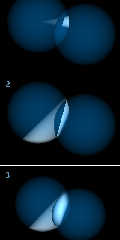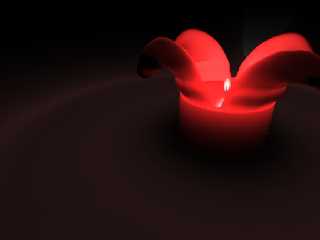 |
 |
|
 |
|
 |
|  |
|  |
|
 |
|
 |
|  |
|  |
|
 |
With great interest, I've been following the recent posts about problems
with overlapping media objects. I've been working on several scenes that
also show some subtle artifacts. But the most vexing (and not at all
subtle) has to do with media objects in a light_group. I thought I'd post
some experiments to show it. Took me awhile to figure out where the problem
was, so hopefully I'll save others some hair-pulling. Haven't *solved* the
problem, unfortunately. :-[
The unit-sized spheres are filled with basic scattering media, using method
3 and extinction 0, with no density maps or varying transparency. No merge
or union, either. (I added a slight amount of emitting media, just to
delineate the sphere shapes; that isn't contributing to the problem.)
I made a light_group out of the left sphere and a spotlight (centered in the
sphere), then overlapped the second media sphere with that light_group,
everything positioned on the same z-plane. The camera is looking
straight-on at the spheres. The result is odd: In image #1, the lens-shaped
overlapping section shows lit media on one side of its central "axis" but
not on the other. It's not a max_trace_level problem, and no amount of
fiddling with media intervals or samples min, max can get rid of it.
Perhaps it's just logical behavior; though to my way of thinking, BOTH
"halves" of the lens-shaped section should be lit (or both should be
un-lit.) I could be wrong, though. Can anyone out there explain what's
going on?
For image #2, I moved the spotlight outside of both spheres (although it's
still part of the light_group.) For image #3, I moved the camera to the
left; the oval-shaped outline is the edge of the overlapping spheres.
There are ways around this, of course: merging the spheres before combining
them in the light_group; or making light_groups out of both spheres,
duplicating the spotlight and its position for both of them. But in my own
scenes, this isn't what I had planned on, and will take quite a bit of
reworking. Perhaps that's inevitable...
Ken
Post a reply to this message
Attachments:
Download 'media_tests.jpg' (37 KB)
Preview of image 'media_tests.jpg'

|
 |
|  |
|  |
|
 |
From: Thomas de Groot
Subject: Re: overlapping media objects in a light_group
Date: 23 Feb 2006 03:52:24
Message: <43fd77c8@news.povray.org>
|
|
 |
|  |
|  |
|
 |
I remember having those kind of problems with Gilles Tran's MakeCloud macro.
Overlapping containers showed up in the image, but sometimes even
non-overlapping ones did, when they were one behind the other and not
touching. I think Gilles mentioned it on his website (I have not checked
now).
Thomas
Post a reply to this message
|
 |
|  |
|  |
|
 |
|
 |
|  |
|  |
|
 |
Hmm...
It just occured to me what the cause of this little puzzle is. Naturally,
the solution has come to me only *after* posting my question. :-[
The sphere to the right is not part of the light_group, so where it intrudes
into the left sphere, the light doesn't interact with that part of it...the
"left side" of the lens shape. Very logical. The part of the left sphere
that's on the "right side" of the lens shape IS part of the light_group,
and its media is being lit as it should be. Again, very logical. The fact
that my camera is looking straight-on at the spheres is the cause of the
"artifact" It's just a viewing-angle problem!
Ken
Post a reply to this message
|
 |
|  |
|  |
|
 |
From: Tim Nikias
Subject: Re: overlapping media objects in a light_group
Date: 23 Feb 2006 05:01:05
Message: <43fd87e1@news.povray.org>
|
|
 |
|  |
|  |
|
 |
> The unit-sized spheres are filled with basic scattering media, using
method
> 3 and extinction 0, with no density maps or varying transparency. No merge
> or union, either. (I added a slight amount of emitting media, just to
> delineate the sphere shapes; that isn't contributing to the problem.)
I seem to remember something about method 3 being part of the trouble with
overlapping containers. Though method 3 is fast and gives nice results with
lower settings, method 2 does a better job because of the fixed intervals
that it will use. Experiment with that. Helped me in the past with the
rendering of a lotus-candle, as method 3 always created artifacts when
exiting and reentering the same object. But it also helped in some other
cases with overlapping containers.
Regards,
Tim
--
aka "Tim Nikias v2.0"
Homepage: <http://www.nolights.de>
Post a reply to this message
Attachments:
Download 'lotus_candle.jpg' (32 KB)
Preview of image 'lotus_candle.jpg'

|
 |
|  |
|  |
|
 |
|
 |
|  |
|  |
|
 |
That makes sense, because pov decides which light group the media's in by
seeing what the last surface was that the ray passed through. This is of
course wrong, because what you want to happen is for it to compute one media
with the light and the other without, but presumably pov just hasn't got a
way to represent that information internally.
You've just reminded me that the media I was struggling with was inside a
light group, perhaps that was my problem. I'll do a quick test... nope, I
think mine was something different.
--
Tek
http://evilsuperbrain.com
"Kenneth" <kdw### [at] earthlink net> wrote in message
news:web.43fd85cbdd458578a416ed930@news.povray.org...
> Hmm...
>
> It just occured to me what the cause of this little puzzle is. Naturally,
> the solution has come to me only *after* posting my question. :-[
>
> The sphere to the right is not part of the light_group, so where it
> intrudes
> into the left sphere, the light doesn't interact with that part of
> it...the
> "left side" of the lens shape. Very logical. The part of the left sphere
> that's on the "right side" of the lens shape IS part of the light_group,
> and its media is being lit as it should be. Again, very logical. The fact
> that my camera is looking straight-on at the spheres is the cause of the
> "artifact" It's just a viewing-angle problem!
>
> Ken
>
>
> net> wrote in message
news:web.43fd85cbdd458578a416ed930@news.povray.org...
> Hmm...
>
> It just occured to me what the cause of this little puzzle is. Naturally,
> the solution has come to me only *after* posting my question. :-[
>
> The sphere to the right is not part of the light_group, so where it
> intrudes
> into the left sphere, the light doesn't interact with that part of
> it...the
> "left side" of the lens shape. Very logical. The part of the left sphere
> that's on the "right side" of the lens shape IS part of the light_group,
> and its media is being lit as it should be. Again, very logical. The fact
> that my camera is looking straight-on at the spheres is the cause of the
> "artifact" It's just a viewing-angle problem!
>
> Ken
>
>
>
Post a reply to this message
|
 |
|  |
|  |
|
 |
|
 |
|  |
|  |
|
 |
"Tek" <tek### [at] evilsuperbrain com> wrote:
> That makes sense, because pov decides which light group the media's in by
> seeing what the last surface was that the ray passed through. This is of
> course wrong, because what you want to happen is for it to compute one media
> with the light and the other without, but presumably pov just hasn't got a
> way to represent that information internally.
>
Yes, I see what you're getting at; things aren't quite as logical as I
thought they were.
It would *seem* that, where the light_group sphere on the left intrudes into
the right-hand sphere (the "right half" of the lens shape), the media there
shouldn't be lit either--because that sphere's media isn't part of the
light_group. Yet the light_group's media apparently takes precedence there.
What a brain-twister!
Ken com> wrote:
> That makes sense, because pov decides which light group the media's in by
> seeing what the last surface was that the ray passed through. This is of
> course wrong, because what you want to happen is for it to compute one media
> with the light and the other without, but presumably pov just hasn't got a
> way to represent that information internally.
>
Yes, I see what you're getting at; things aren't quite as logical as I
thought they were.
It would *seem* that, where the light_group sphere on the left intrudes into
the right-hand sphere (the "right half" of the lens shape), the media there
shouldn't be lit either--because that sphere's media isn't part of the
light_group. Yet the light_group's media apparently takes precedence there.
What a brain-twister!
Ken
Post a reply to this message
|
 |
|  |
|  |
|
 |
|
 |
|  |
|  |
|
 |
BTW, something I forgot to mention: Although it may not be very apparent
from my images, the media on the right-side of the lens shape is actually
twice as bright as the media inside the light_group sphere. The only
conclusion I can reach is that the spotlight is interacting with the medias
of BOTH spheres there. (This does usually happen when two media containers
are simply overlapped...the media densitites "add together"...but since only
one media is in the light_group and the other isn't, that doesn't seem quite
right.)
Ken
Post a reply to this message
|
 |
|  |
|  |
|
 |
|
 |
|  |
|
 |




![]()